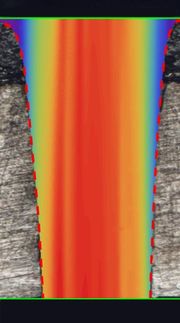Scanning Tunnelling Microscopy: Computer Simulations Sharpen Insights into Molecules
The resolution of scanning tunnelling microscopes can be improved dramatically by attaching small molecules or atoms to their tip. The resulting images were the first to show the geometric structure of molecules and have generated a lot of interest among scientists over the last few years. Scientists from Forschungszentrum Jülich and the Academy of Sciences of the Czech Republic in Prague have now used computer simulations to gain deeper insights into the physics of these new imaging techniques. One of these techniques was presented in the journal Science by American scientists this spring. The results have now been published in the journal Physical Review Letters.

Forschungszentrum Jülich
"A comparison between the experimental results and our simulations shows excellent agreement and that, therefore, our theoretical model is able to explain the mechanism behind the microscopic images in this family of techniques," says Prof. Tautz from Forschungszentrum Jülich. "This comparison is essential for analysing the images."
Together with his colleagues from the Peter Grünberg Institute (PGI-3), in 2008 Tautz introduced the method of attaching single molecules – initially hydrogen molecules, later molecules such as carbon monoxide – to the tip of a scanning tunnelling microscope and using them as extremely sensitive measuring probes. The scientific community responded with great interest to this method, and the technique has since been continuously refined. It enables scanning tunnelling microscopes to be used as a kind of atomic force microscope that is able to image the geometric structure of molecules with unprecedented accuracy.
"The valence charge clouds of complex organic molecules often spread over the entire molecule, thus concealing its atomic structure," says Tautz. Flexibly bound molecules at the microscope tip can be utilized as tailor-made sensors and signal transducers that are able to make the atomic structure visible nevertheless.
In the last few years, such atomic sensors have also proven useful for work with atomic force microscopes. Then, in May 2014, scientists from the University of California, Irvine, showed for the first time that these sensors can also be used to improve signals in a related imaging mode known as inelastic electron tunnelling spectroscopy. In this case, it is the vibration of the sensor molecule against the microscope tip that reacts sensitively to the surface potential of the scanned sample.
"Our calculations show the effect of the electrostatic forces on the high-resolution AFM, STM, and IETS images", explains Dr. Pavel Jelínek from the Institute of Physics at the Academy of Sciences of the Czech Republic in Prague. "We believe that the results of this work are an important contribution to the use of inelastic electron tunnelling spectroscopy that will allow the technique to be used as an additional source of information in materials science and to derive additional parameters from the images."
Original publication
Prokop Hapala, Ruslan Temirov, F. Stefan Tautz, Pavel Jelínek Origin of High-Resolution IETS-STM Images of Organic Molecules with Functionalized Tips Phys. Rev. Lett. 113, 226101 (2014) – Published 25 November 2014
Prokop Hapala, Georgy Kichin, Christian Wagner, F. Stefan Tautz, Ruslan Temirov, Pavel Jelínek Mechanism of high-resolution STM/AFM imaging with functionalized tips Phys. Rev. B 90, 085421 – Published 19 August 2014
Most read news
Original publication
Prokop Hapala, Ruslan Temirov, F. Stefan Tautz, Pavel Jelínek Origin of High-Resolution IETS-STM Images of Organic Molecules with Functionalized Tips Phys. Rev. Lett. 113, 226101 (2014) – Published 25 November 2014
Prokop Hapala, Georgy Kichin, Christian Wagner, F. Stefan Tautz, Ruslan Temirov, Pavel Jelínek Mechanism of high-resolution STM/AFM imaging with functionalized tips Phys. Rev. B 90, 085421 – Published 19 August 2014
Organizations
Other news from the department science

Get the analytics and lab tech industry in your inbox
By submitting this form you agree that LUMITOS AG will send you the newsletter(s) selected above by email. Your data will not be passed on to third parties. Your data will be stored and processed in accordance with our data protection regulations. LUMITOS may contact you by email for the purpose of advertising or market and opinion surveys. You can revoke your consent at any time without giving reasons to LUMITOS AG, Ernst-Augustin-Str. 2, 12489 Berlin, Germany or by e-mail at revoke@lumitos.com with effect for the future. In addition, each email contains a link to unsubscribe from the corresponding newsletter.

























































